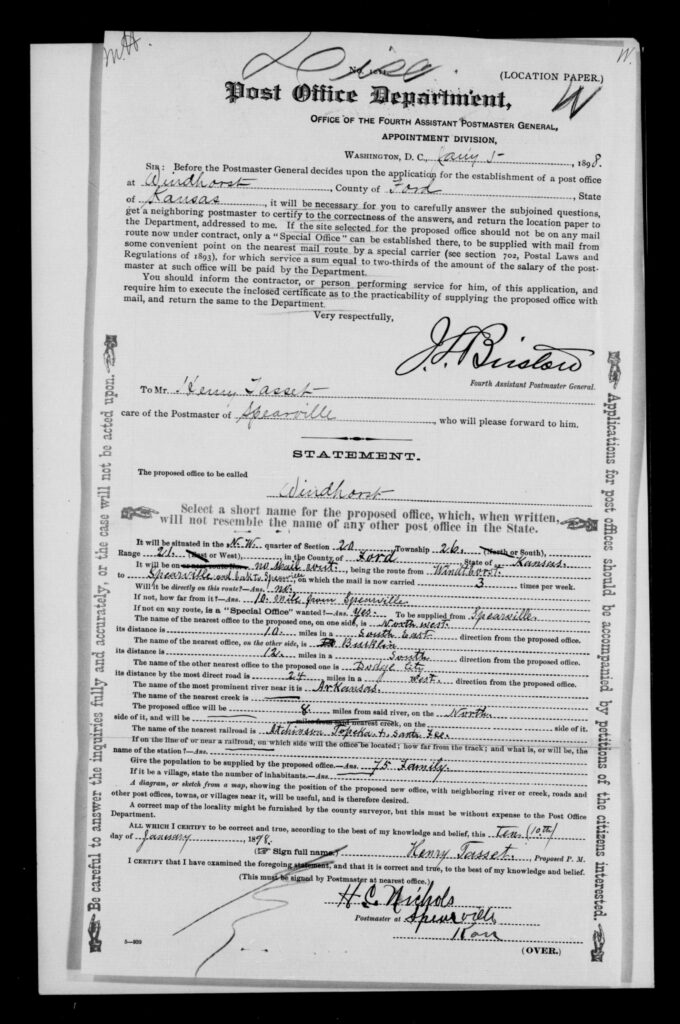[Excerpt from Dodge City and Ford County, Kansas 1870-1920 Pioneer Histories and Stories. Copyright Ford County Historical Society, Inc. All Rights reserved.]
The creation of Windthorst took place in 1876, when a number of men met at the Arbeiter Hall in Cincinnati, Ohio. These men were from various trades: cobblers, tailors, carpenters, foundry workers, tanners, blacksmiths and common laborers. They were attempting to better their conditions in this land of opportunity.
Several meetings were held by these German men and the German Catholic Aurora Homestead Association was formed with Henry Macke named President and John Luzins named Secretary. Correspondence was carried on with Father Felix Schwemberg of Newton, Kansas, who together with D.C. Schmidt, general land agent of the Santa Fe Railroad, showed great interest in the proposed aims of the Homestead Association. Land agents at Little Rock, Arkansas, were also contacted by mail about land available in northwest Arkansas. Schmidt went to Cincinnati, to meet with the Association and recommended a tract of land in Ford Co., Kansas, 10 miles southwest of Offerle.
The men of the Aurora Association agreed they needed to send their own representative to Arkansas and Kansas before making any commitment. An exploring Committee made up of Frank H. Klenke, Henry Tasset and Herman Thesing, were responsible to view these areas. The committee went first to Arkansas, and then to Kansas, where they met Mr. Schmidt at Offerle, then on to an exploring tour in Ford County. This area appealed more to them than the Arkansas land because of the buffalo grass, fertile soil, good water supply at a reasonable depth and an invigorating climate.
They returned to Cincinnati and the Association held several meetings along with Mr. Schmidt, who took a lively interest in the discussions. He finally brought the deal of 10 sections of Santa Fe land to a close, offering to sell the land for 10 dollars per acre on a long-term basis. To show his good will, he informed them that the railroad company would donate 80 acres of land for a town site in the center of the 10 sections.
It was also agreed that each man could buy the limit of 80 acres within the railroad confines and that one parcel of land, 80 acres, was to be deeded without charge for church, school and cemetery purposes. The name of the new settlement was decided upon when Frank H. Klenke proposed the name of Windthorst, in honor of Dr. Ludwig Von Windthorst, who at that time was the leader of the Catholic Center Party, and a bitter opponent of Bismarck, the Iron Chancellor of Germany.
In the fall of 1877, 12 men came out and made the deal with the Federal Land Agent. Upon their return to Cincinnati, they mapped out the town site of Windthorst, deciding on the location of the church, school and cemetery. The balance of the 80 acres was divided into town lots, and were sold to the highest bidder, regardless of whether they were members of the Association or not. The bidding was lively, especially in the business section, since the land agent had indirectly hinted that the Santa Fe Railroad might run a branch from Offerle to Windthorst. The branch line was never built and the dream of Windthorst becoming a town was never realized.
Although Windthorst did not become a town with a business center, the community developed rapidly around the church, school and parish hall, with a close and supportive relationship. The first church was built in the spring of 1879, after use of the parlor in the home of Henry Tasset for the first year for religious services. The cost was $750 and assistance was offered by the Aurora Association in Ohio. The bell for this first church was donated by St. Paul’s Church, the home parish of the immigrants.
By 1892, there was need of a larger church and in 1913, the present church was dedicated. At that time the census shows the congregation as 395 in number. The church was considered “one of the finest in the west,” according to Bishop Hennessy who presided at the dedication ceremony.
Today, the church has earned renown for its architecture and the pre-Vatican II grandeur, the canopy, high altar, statuary, and stained glass windows. These were hand-crafted by workmen at the Emil Frei Studios in Munich, Germany. The Immaculate Heart of Mary Church has been placed on the National Register of Historic Places by the U.S. Department of Interior. Each year, especially at Christmas time, it attracts many visitors and is the focal point for returning descendants of the enterprising team who left the northeast to “better themselves.” on the verdant Kansas prairie.
Urban Klenke
*Note: The Windthorst Post Office operated from 1898 until 1905.
Dodge City and Ford County, Kansas 1870-1920 Pioneer Histories and Stories is available for purchase from the Ford County Historical Society.



